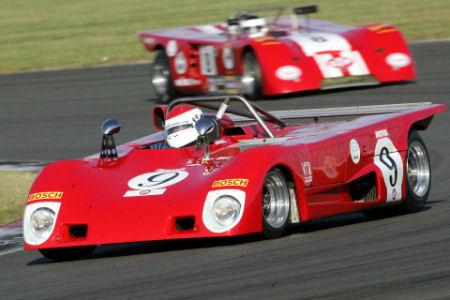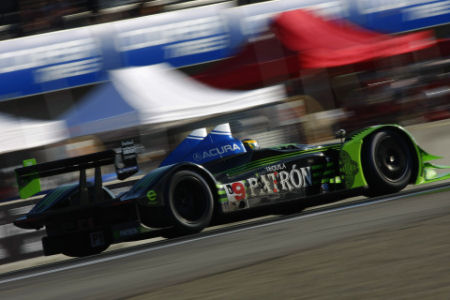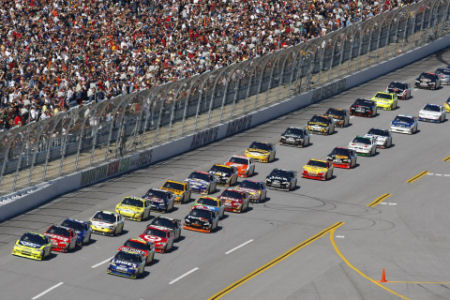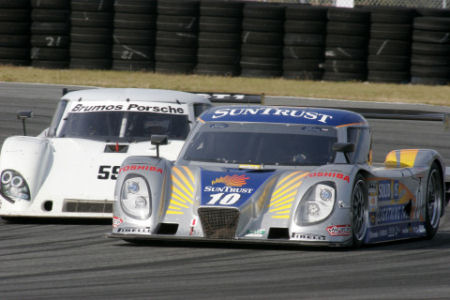The Way It Is/ American racing's leadership vacuum
by Gordon Kirby My old friend Bobby Rahal said it quietly and clearly in his first 'Racing Life' column in the February issue of Motor Sport. Writing about this year's launch of Historic Motor Sport Productions, the organization he's founded with Zak Brown and Peter Stoneberg to promote three historic/vintage racing weekends, Bobby comments: "It's got to be better than sitting around wondering what's going to happen next."
My old friend Bobby Rahal said it quietly and clearly in his first 'Racing Life' column in the February issue of Motor Sport. Writing about this year's launch of Historic Motor Sport Productions, the organization he's founded with Zak Brown and Peter Stoneberg to promote three historic/vintage racing weekends, Bobby comments: "It's got to be better than sitting around wondering what's going to happen next."
With professional open-wheel and sports car racing in America descending in recent years to an all-time low in crowd draw and media coverage historic and vintage racing have emerged as the strongest, most stable forms of the sport. Crowds and competitors continue in almost undiminished numbers at most historic events and Rahal, Brown and Stoneberg have decided to convert their enthusiasm for historic racing into a business. It is, as Rahal says, a labor of love, but you can be sure Bobby and his partners see a potentially worthwhile return down the road.
"I think there's so much interest in historics right now," Bobby writes in the latest Motor Sport, "because people are disillusioned with the modern sport's preoccupation with 'spec' racing, where all the cars look and sound the same.... People like to see cars that were the idea and creation of one man, rather than cars built to a formula."
As any regular reader knows, I am entirely in Rahal's camp when it comes to loving historic racing and loathing spec cars. I believe the devolution of most American racing over the first decade of the 21st century to spec car-like formulae has had a major role in the sport's dwindling appeal, NASCAR included. The fans of motor racing want to see new, different and aesthetically attractive cars with engines of equal variety and aural attraction. During most of racing's first hundred years through the twentieth century the sport remained faithful to these essentials, but no longer. A crying lack of leadership over many decades has devalued motor racing in America and driven away many traditional fans.

© LAT USA
"I used to be a big NASCAR fan but I don't care anymore," the chorus sings. "I really don't care about any of those drivers, except maybe Mark Martin, and I hate the CoT. I want to see a Ford racing against a Chevy or a Dodge, or even a Toyota, not a bunch of ugly-looking cars that are all the same."
Of course NASCAR's entire business model, based on ever expanding growth, has turned on itself over the past two years and much wiser management will be required by NASCAR, ISC and SMI than was encouraged by the hubris-filled past decade. One example is the cutback in seating recently announced at many NASCAR tracks. And of course, NASCAR will be the most hard-pressed of all forms of motor sport to respond technically to transform its outdated formula to accommodate the inevitable increasing social and governmental pressures to 'go green' over the coming decade. It will require more than a belated move to fuel injection.
In my US Scene column in the January edition of Motor Sport and in this space last November ALMS champion team owner Duncan Dayton made it clear how he sees the future. Dayton would like to see the ALMS be much more aggressive about defining and marketing its green initiatives and his comments deserve restating.
"If I were involved with running the ALMS," Dayton said. "I would go to the government and say rather than spending $20 million-$40 million in sponsorship from the National Guard, Air Force and the Army in NASCAR and Grand-Am on the biggest-polluting, most technically unsophisticated cars in America the government should give that money to the ALMS and put up an X-prize with some financial reward for pushing green technology forward.
"To me," Dayton continued, "we want to be thinking about zero carbon footprint race cars. Not by buying carbon credits but by actually designing and building a car that's going to be a zero emission car that can go 200 mph and run for forty-five minutes or an hour on whatever kind of charge it needs, whether it's full electric or whatever.
"I think 2010 will be a bit of a muddle-through year [for the ALMS]," Dayton added. "But we need a new rules package for 2011 and new manufacturers and cars coming in. I think the ALMS has so much interest because it has an open rulebook and a variety of chassis and engines, and we need to generate an even wider range of fuel and solutions. Sports car racing has always lived or died on the whims of the manufacturers but the backbone of sports car racing has always been the privateers. So I'm in favor of cost-cutting and finding ways of limiting the expense of competing. But the main focus should be on aggressively selling and marketing a longterm green plan."

© LAT USA
"Motor sport is number one in showing people how to do it," Audi's chief engine man Dr Ulrich Baretzky told me at Sebring last year. "It's not the job of the politicians to give answers to these questions. It's our job. I don't know that we have all the answers but we can show very quickly what the answers can be.
"We need to educate people to understand that this direction of smaller engines, turbocharging and more efficiency is not something boring. It's a thrill on its own. That is our role and that's one of the reasons I'm still fascinated about motorsport. I think we can very much influence the speed of how the outside world is working and reacting to what we are doing."
A few weeks ago the VW Group's motorsports boss Kris Nissen said VW had no interest in competing in the IRL's much-discussed new IndyCar formula for 2012 with any of its brands--VW, Porsche or Audi. This appears to leave the IRL with Honda as its only possible engine supplier for the new formula which probably means the 2012 engine will be a turbo V-6 rather than the theoretical 'world formula' four-cylinder turbo. Meantime, the future of Indy car racing remains lost in heavy fog.
As we all know the commercial model for the IRL is in dire straights. Indy car racing desperately needs a technical kick-start and must embrace some serious 'green' technology but how can the teams afford to buy and develop new cars and new engines when the crowd numbers and TV ratings are so dismal and consequently sponsorship is so difficult to sell?
I talked at length a few weeks ago with Andretti Autosports technical director Peter Gibbons for the epic history I'm writing about Carl Haas Auto and Newman/Haas Racing. Gibbons has been in the sport for more than thirty years and helped Adrian Newey design some of the mid-eighties March Indy cars before becoming a renowned race engineer and team technical boss for Newman/Haas and now Andretti Autosports. Gibbons believes the IRL must make some essential changes in its philosophy and says he hopes the IRL goes with Ben Bowlby's Delta Wing design for its new car.
"If they don't, then at some point fairly soon it's over," Gibbons remarked. "We've got to take a major step and think way ahead. We need some relevancy. There's no relevancy in what we're doing and even less with what NASCAR's doing. When gas is eight dollars a gallon, which isn't far off, and we're still pounding around in these fat, horrible, heavy cars, we're in trouble."
It should also be a wake-up call to the sport that both Gil de Ferran and Adrian Fernandez are out of business as team owners because they've been unable to sell sponsorship and the manufacturer support they enjoyed in recent years is no longer there. De Ferran and Fernandez were mainstays of the ALMS the last few years and their loss will be sorely felt. De Ferran still hopes to find the backing to return his team to action in Indy cars this year, but Fernandez appears to have quietly retired from the sport as both a driver and team owner.

© LAT USA
"The good news is we're not at zero on the fund-raising battle," de Ferran added. "We've moved on from that level but we're still not at the point where we can say it's a go. Obviously, time is extremely short, but these days you can go and buy the stuff to go Indy car racing. There's a lot of R&D to do and time is short, but at least it's relatively uncomplicated to get the equipment necessary."
Meanwhile, most classic road courses like Road America, Laguna Seca, Lime Rock and Mosport are struggling to find a top-draw professional racing weekend. Both Road America and Laguna Seca have suffered badly from the demise of the thriving CART weekends they enjoyed for twenty years. Laguna Seca has given up trying to pull a crowd for the Grand-Am and switched its struggling ALMS weekend from October to May while Road America will try stock cars this year with a Nationwide race. This will be first time NASCAR has raced at Elkhart since 1957. And of course, the CART/IRL war helped kill the Milwaukee Mile. The world's oldest racetrack--106 years old--appears to be out of business thanks to the yawning lack of leadership for American racing.
Again, it's essential to reiterate the history of failure we've witnessed over the past forty years. The SCCA failed spectacularly with the Can-Am, Trans-Am and F5000 series, IMSA blew its once-great GTP series and of course USAC, CART/Champ Car and IRL have all but destroyed Indy car racing. Techical leadership was supposed to be one of the founding tenets of CART and it was for a while. But politics and power-squabbling got in the way. Advancing technology took a back seat to a total preoccupation with marketing as the solution to CART's woes.
The constantly-changing CART and Champ Car heirarchies blew their chance at rewriting history by bringing in a long line of feckless marketing/shmarketing types who neither appreciated nor knew anything about the sport. In fact, these twits and the bureaucrats the CART and Champ Car owners hired to run their organizations had contempt for motor racing as we once knew it. To them it was just 'A Show', nothing more. Looking back, the first decade of the 21st century was an unmitigated disaster for American open-wheel and sports car racing.
Another important element in American racing's plight is the Perfect Storm that struck the media in the past few years as the web destroyed most newspapers long-standing business models. As a result coverage of racing has been slashed or vanished and most of the old beat racing writers of the past quarter century have been laid off or retired. Few, if any, have been replaced.
In the first week of January the 'NASCAR Scene' weekly newspaper was killed by owners Street & Smith's Sports Group and fifteen reporters were given pink slips. The once-thriving weekly has been folded into the monthly 'NASCAR Illustrated' that will continue to service subscribers to 'The Scene'. 'The Scene' was started in 1979 and sold 130,000 copies per week at its height just a few short years ago. It was still selling 100,000 per week but ad sales fell off precipitously last year.
You can talk all you like about the growth of the web but the fact is any modern, commercial sport needs the print media. All the major sports are well-served by the print media as is motor racing outside the United States in Europe, Japan and Australia. But here in America we are left these days with Speed-Sport News, Racer and AutoWeek as the only print media covering racing--pretty thin gruel and a reflection of motor racing's lack of traction, presence or relevance in the United States these days.

© LAT USA
Meanwhile, next weekend's Rolex 24 hours provides a great winter break-out and draws a wide range of drivers, thanks largely to leading Grand-Am team owners Chip Ganassi and Bob Stallings. But it's nothing like the period from the sixties through the early nineties when the Daytona 24 hours enjoyed worldwide interest with plenty of international and factory teams as well as considerable technical variety. Today, it's literally a big club race. A lot of fun for the racers to be sure, but the race barely exists in the mainstream media. Whenever I mention to anyone at home that I'm preparing to leave for Daytona they all know about the 500 but they've never even heard about the twenty-four hour race.
The Grand-Am's hierarchy believes in the NASCAR model of close racing and bedamned to technology and aesthetics. They believe a bunch of cars running around close together is what it's all about, yet it's manifestly obvious by the utter lack of following for the Grand-Am series that they are chasing down the wrong road. The fact is the Rolex 24 hours and Sebring 12 hours need to have the same field of drivers, cars and teams, and the cars need to be technically-interesting and aesthetically attractive.
To me and thousands of race fans I've heard from in recent years, this is a no-brainer. In a perfect world the Grand-Am and ALMS would get together with ALMS-type rules! But that's hardly likely because both series have separate and competing power bases replete with a brace of racetracks to run their races and opposing technical philosophies.
Unfortunately there's no structure to the sport to give us the leadership we need and certainly no sign that I can see of the bright and powerful personality required to turn the sport around. Under Bobby Rahal's leadership the Road Racing Drivers Club is doing some good things for the sport such as supporting Team USA and launching in company with the FIA a 'Young Drivers Symposium' that debuted at December's PRI Show in Orlando. Another of these RRDC/FIA young driver symposiums will take place at Long Beach in April.
These are great things but much more needs to be done. Nick Craw is a longtime RRDC member and the chief of ACCUS (the Automobile Competiton Committee of the United States) as well as vice-president of the FIA and president of the FIA's senate. Nick would have a lasting influence on the sport if he could convince the FIA to take a more active role in pushing American racing into the 21st century.
Many people suggest that new FIA president Jean Todt will turn out to be a much more enlightened leader than Max Mosley. Todt knows the automobile industry well, is a fan of technology and is said to be a master conciliator in sharp contrast to Mosley. If so, I'd like to see Craw motivate Todt and the FIA to push the Grand-Am and ALMS to get together for the betterment of American and international sports car racing as well as pushing America's sanctioning bodies to be much more aggressive in joining the global move to 'green' automotive technology.
Something must happen soon. If not, racing in America seems destined to prove itself to be a moribund sport of the 20th century that was unable to evolve with the changing times.
Auto Racing ~ Gordon Kirby
Copyright 2010 ~ All Rights Reserved
Copyright 2010 ~ All Rights Reserved
Top of Page